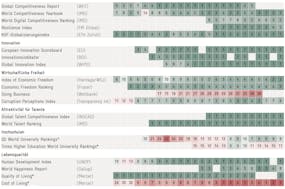Working hours are becoming a hot topic. Digitization in particular has prompted a broad discussion about how people’s workload is developing. In principle, the number of hours worked per employee has fallen significantly over the long term, while more wealth has been created thanks to higher productivity. Now, there are fears employees will have to work more and more in future.
A decrease of 22 hours on average
The graphs show the development of paid working time between 2010 and 2016 (reflections on the influence of unpaid working hours can be found here). Fears that working hours rose are not confirmed by the numbers: after 2010, working hours per full-time position initially fell significantly, before rising again slightly between 2013 and 2015. From 2010 to 2016, the actual annual working time per full-time position dropped by an average 22 hours in all sectors*. (The calculation is based on actual annual working time per full-time position including overtime and excluding absences.) The federal statistics are sufficiently detailed to break down working hours by gender, nationality and sector. However, the roles of different levels of training and seniority are not covered.
Agriculture and forestry stand out especially, with the workload falling by an impressive 51 hours over the period. Working hours also declined in nine other sectors – although not everywhere to the same extent. By contrast, employees in the art and other services categories saw a slight increase in working hours.
Large differences in working hours between men and women
Breaking down the data by gender reveals that women in all sectors on average saw a stronger decline in annual working hours than men – also when measured in actual working hours per full-time position. The gender difference was most pronounced in information and communications. Here the trend was reversed. While 41 hours were added for women, the working hours for men in the same industry fell by 30 hours.
Differences between Swiss and foreigners
Differentiated by nationality, the figures reveal a 28-hour decline for foreigners – more pronounced than the average reduction of 20 hours for Swiss nationals.
The strongest decline was again in agriculture and forestry for both foreigners and nationals. The annual working hours there fell by 85 and 64 hours respectively. However, the length of work increased, depending on nationality, in other sectors. Swiss nationals saw longer working hours in transport and warehousing. For foreigners, annual working hours only increased in the field of art and other services.
Over the medium term, it can be concluded that workload fell in most sectors – but not universally by sector or equally for all employees.
_______________________________________________________________________
*Data basis for the years 2010 to 2016, according to the Federal Statistical Office. Some of the results should not be over interpreted due to statistical blurring. Full-time employees with an employment level of 100% were taken into account. This does not apply to employees in the company and apprentices.





